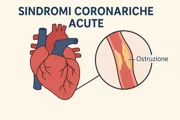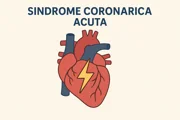Acute coronary syndromes can present themselves as a lack of blood flow to a part of the heart. For this reason, we can speak not of a single pathology but of a series of problems that can affect the heart muscle.
Let's see what they are. We could be dealing with a problem called myocardial infarction. It could be a case of unstable angina. Regardless of the specific pathology, it's important to delve deeper into the heart muscle, its specific functions, its structure, and its exact location.
Let's talk about the heart
What exactly is the heart? The most accurate definition we can give it is that it is a muscle. Where exactly is it located? The heart is located in an area called the inferior mediastinum, where the lungs are also located. Its specific function is to circulate blood throughout the body.
What are the structures it uses to perform this very important task? It uses a network of veins and arteries that carry blood pumped by the heart throughout the body.
It's a muscle divided into two halves. Each halves is in turn composed of an internal chamber. The internal chamber contains an atrium located in the upper part of the heart and a ventricle located in the lower part.
Initially, blood lacking adequate oxygen enters the right atrium and is pushed toward the lungs. In this area, carbon dioxide is released and oxygen is enriched.
Once the blood has been purified of carbon dioxide and enriched with oxygen, it is pushed into the left atrium of the heart and, through the left ventricle, is pumped into the arteries, which distribute the oxygen-rich blood throughout the body.
If a person presents with a very acute coronary problem, they will experience a series of symptoms and signs.
Symptoms
What might happen to a person affected by this problem? Let's imagine for a moment the creation of a partial obstruction in the area of the arteries, blocking the blood flow that should be properly reaching them.
What is the cause of this obstruction? It could be a sort of thickening of the vessel walls caused by the accumulation of lipids. These deposits are also called atherosclerotic plaques.
Another factor that should not be underestimated in this dynamic described is the possibility that one of these plaques could rupture and consequently cause damage to the blood vessel.
What symptoms will a person experience if there is a partial or total obstruction to blood flow? The person will experience a series of symptoms, some of which could be serious, such as:
The person may experience diffuse pain in the chest area;
The person may begin to experience labored breathing;
The person may experience problems such as tachycardia.
If a patient goes to the emergency room complaining of localized pain in the chest area, it is important to undergo a series of tests to determine whether it is a heart attack or unstable angina.
Acute myocardial infarction and unstable angina
What are the substantial differences between an acute myocardial infarction and unstable angina? In unstable angina, the decreased blood flow is a persistent condition that will cause the death of part of the heart muscle tissue.
Acute coronary problems: what are the symptoms?
If a patient were to experience acute coronary problems, what specific symptoms would they experience? The first symptom would be chest pain that could spread to the shoulder and arm area. However, this is just one of the symptoms; there are others that we will examine in detail.
The patient may experience pain and tightness in the chest area;
The patient may have a rapid heartbeat;
The patient may feel nauseated;
The patient may begin to sweat profusely;
The patient may experience breathing difficulties;
The patient may experience general fatigue.
Risk Factors
Are there risk factors that influence a patient suffering from, for example, an acute myocardial infarction? Let's see what they are:
A risk factor in this sense is a person suffering from hypertension;
A risk factor in this sense is a person suffering from hypercholesterolemia;
A risk factor is being overweight;
A person who leads a sedentary lifestyle and does not participate in any type of physical activity;
A person who smokes;
A person of a certain age;
A person who uses drugs;
A person with a high level of stress. For more on stress see also burnout.
Diagnostic Tests
What diagnostic tests should a person undergo when they come to the emergency room complaining of chest pain? The first test ordered is a troponin test. What is it? It's a biomarker that detects potential cardiac damage. For example, a decrease or increase in troponin levels could indicate the presence of:
The person may be having a heart attack;
The person may have heart muscle damage.
Another test that may be ordered is a BNP level, which stands for b-type natural peptide. These are proteins that are released into the body during a heart attack.
Patient's General Health
How should we assess the patient's general health? Tests may be performed to assess kidney and liver function. A complete blood count will certainly be performed to assess the presence of any underlying conditions, such as anemia.
What tests can be performed for the patient's chest pain? A physical examination will certainly be necessary to assess:
The patient's age;
If the patient has diabetes;
If the patient smokes.
Another test that will be performed is an electrocardiogram, which will allow us to assess the heart's actual rhythm and electrical activity.
Treatment approaches
For a medical reference see NCBI Bookshelf – Acute Coronary Syndrome.To reduce the symptoms of acute coronary syndromes, both pharmacological and surgical interventions can be used. To this end, the patient may be given:
Aspirin to reduce blood clotting;
Thrombolytic drugs may be used;
Painkillers may be used;
Nitroglycerin may be administered to reduce chest pain;
Beta-blockers may be administered to slow the heart rate;
Anticoagulants may be administered to reduce blood clotting.
Surgically, a surgical technique may be used that involves inserting a balloon-shaped catheter into the coronary artery at the site of the narrowing. This catheter is then inflated to remove the obstruction. A technique called coronary artery bypass grafting could be used, which involves using a segment of a blood vessel to bypass the blockage in the artery and alter the path of blood flow.

